Natural History Museum building
Giraffes in the Gymnasium
The Natural History Musem building has been part of Helsinki since 1913. The near-centenarian building has maintained its external appearance in its original form throughout the eclectic decades.
The building was initially designed as a modern Russian school for boys. However, it served that function for only four years. After Finland gained its independence (1917), the gymnasium building first served Helsinki’s Jaeger Regiment and as the Headquarters of the Army, before transforming into Finland’s first Cadet School. The University of Helsinki bought the building from the government in 1923, and placed its zoological collections there – the gymnasium morphed into a museum.
The Gymnasium of Alexander 1913–1917
The Gymnasium of Alexander, which was built in 1870, was originally situated on Heikinkatu, that is, the present-day Mannerheimintie. Soon, the school needed more space, and in 1908, the principal at the time, Victor V. Belevitš , applied for a plot of land for the new school building. Etu-Töölö had been recently covered by a street plan, and was the ideal location for the new school. The Russian army’s Turku barracks in Kamppi and the green garden-areas of Arkadia were situated nearby. Principal Belevitš succeeded in his plan, and the school secured seven plots from block number 404.
Principal Belevitš planned the functional and ideological purpose of the new gymnasium building. The official ground plan and façade was designed by Lev Siško, counsellor of education from St. Petersburg . Siško’s assistant and supervisor of constructions was another architect from the same city, Mihal Tšaiko.
When the stately school was erected on Arkadiankatu, it was the first building on the block. Its dignified inauguration was held on December 28 1913, in the grand auditorium. The brand new gymnasium building was dedicated to the late Russian tsar Alexander II. The imperial emblems, the crown and monogram, stood above the main entrance. These can be seen in the picture in which the eldest pupils are standing in front of the gymnasium building.
Exceptional neo-baroque
The gymnasium was made to be exceptionally distinguished. The stately building was intended to “last an entire century”. It represents the neo-baroque style, which was uncommon for turn-of-the-century Russian constructions and is rare in Helsinki. Perhaps it was for this reason, that the building was preserved during the tumultuous early years of Finnish independence, unlike many other buildings that were reminiscent of Russian rule.
The school’s baronial auditorium was situated on the third floor by Arkadiankatu. It was a soaring hall with arched ceilings, in which the stage was situated on the west-side, the orchestra-gallery was to the east and was accessible from the broad stairway.
The newest new in the school-world
The new school building was in many ways progressive. Classrooms were large and spacious, and they were organized according to the different subjects, instead of class years. During their time at the gymnasium, the boys would study Latin, Drawing, Physical Education, Natural Sciences, Geography, and Chemistry, among other subjects.
The classrooms were situated by the corridors on the three-floor wing facing Nervanderinkatu. The younger pupils were on the 2 nd floor and the elder ones were on the 3 rd. The spacious corridors were used for recess.
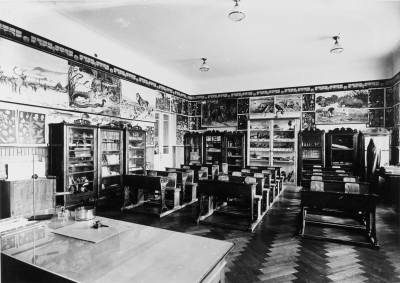
Let the children come to me
A small church hall and an orthodox chapel on the 3rd floor were used for the gymnasium’s Religious Instruction classes. The place where the church hall and chapel were situated can still be distinguished from the outside walls of the building, even though the cross that stood on the roof is gone. From the inner court, the place where the church hall used to be is still marked by an orthodox cross, on which the crossbar is inexplicably the wrong way around.
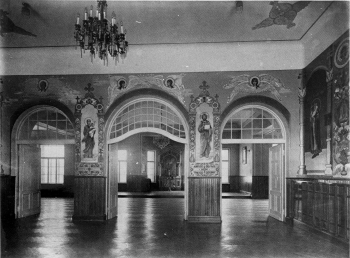
On the side facing Nervanderinkatu, a large kiot, or icon display case, stood in the arched hollow of the chapel. The kiot contained icons representing the Romantic style, the theme of which was “Let the children come to me”. This icon from 1870 is displayed in its original kiot at the Uspenski Cathedral in Helsinki. The religious murals in the church hall were painted at a later date when the gymnasium was still operating.
The multitude of old photographs showing icons of the patron saint of the building, Our Lady of Kazan, are indicative of the Orthodox faith being practiced at the gymnasium.
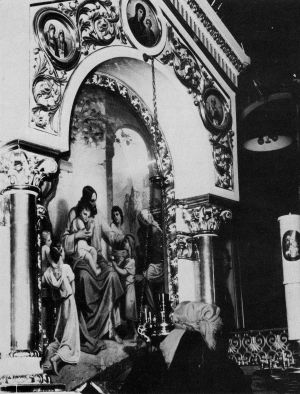
Cadet School 1919–1923
The Gymnasium of Alexander came to an end when Finland gained its independence in 1917. All Russian establishments were closed down and their property was transferred to the Finnish government. During this time, the imperial emblems were removed from the main entrance.
The Jaeger Regiment of Helsinki, followed by the commander-in-chief of the newly established Finland, along with its headquarters, moved into the gymnasium building. In 1918, the White Army’s medical division operated in the building. Mandatory military service stepped in and the government commenced military training. The gymnasium transformed into Finland’s first Cadet School in January 1919.
Cadet life
The new officer-training received many enthusiastic applicants. The first year comprised, for the most part, of young men who had already received some form of military training. The school accommodated two year-groups, in which they received a year and a half of training in total. Classes were conducted in Finnish.
The subjects included Tactics, Languages, Mathematics, Military History, Fort Design, Weapons Training, Hippology (Equine Studies), and Martial Laws. Practical courses entailed field- and weapons-training, which were held at the nearby Turku barracks in Kamppi.
The cadet trainees were accommodated in eight of the gymnasium’s former classrooms, on the 2 nd and 3 rd floors. 14-15 cadets fit into each room, in which each had their own bunk, stool, and locker.
Life at the Cadet School was very disciplined. A guard stood by the main entrance at all times to verify that all visitors had an entry-pass.
Cadet trainees who broke rules were sent to the turret on the roof for detention. Their scribbles could still be seen on the walls of the turret in the beginning of the 2000s. During the renovations, signatures of the cadets were found in the balcony of the auditorium.
A festive ball was held at the Cadet School twice a year, in the spring and autumn. One of the most prominent people in Finland’s history, regent and cavalry general Carl Gustaf Emil Mannerheim attended the first ball at 24th of March, 1919.
Zoological Museum 1923–1995
The Cadet School moved out of the gymnasium building only after a few years of being in operation. The new owner of the building was the University of Helsinki, which bought the entire Arkadiankatu-block number 404 from the government in 1923. The university had been in dire need of the space, as the Zoological Department and its national collections had been cramped into various locations. The gymnasium’s transformation into the Museum of Natural History had begun!
The transportation company Victor Ek kindly provided their automobiles to the University of Helsinki, and the stuffed animals traveled regally from the Senate Square to Pohjoinen Rautatiekatu. The migration caravan aroused plenty of interest on the streets of Helsinki, and the event was recorded into the Helsingin Sanomat and Victor Ek picture-archives.
After a couple years of organizing and repairing the exhibits, the Zoological Museum was opened to the public in 1925.
The gymnasium’s classrooms transformed into offices and space for the collections, and the auditorium and corridors converted into exhibition halls. The bird-collections were nestled onto the 2 nd floor, and the mammal-collection placed in the old auditorium. The researchers and university students also benefited from the new exhibition halls, because up until then, part of the specimens had remained boxed and out of reach, even from researchers.
The collections The present-day collection is founded by one donated to the University of Helsinki by the Societas Pro Fauna et Flora Fennica-society in 1858. In addition to donations, the museum’s collection was amassed by purchases and exchanges in the 1800s. Various hunting- and collection-expeditions throughout the decades have also added to the exhibits. Nowadays, however, this is no longer practiced because new specimens are given to the museum by members of the public who encounter dead animals. accumulate…
In the 1950s, the museum bought a large collection of skeletons from anatomy professor Evert Julius von Bonsdorff. To accommodate them, the large auditorium on the 3 rd floor was split in the 1960s into two floors. The skeletons then took over the new 4 th floor exhibition area.
’The Story of the Bones’ exhibition situated on the 1st floor is based on the old Bonsdorff skeleton-exhibit, which can be seen in the pictures.
…and the building changes
The internal-decor of the museum building began to change in the swinging 1960s: in addition to splitting the top floor in two, various galleries and work-areas were built into high-ceilinged rooms, and work-spaces were divided by new walls. The religious wall paintings in the old Orthodox hall were covered under a white layer of paint and the gym on the first floor was made into a lecture hall.
The museum opens and the exhibits are renewed
For decades, the primary function of the Zoological Museum and its collections was to serve the university students and researchers. The exhibits were open to the public only on Sundays for four hours. In that brief time, the public was allowed to marvel at the displays, arranged according to their scientific classification: there were birds standing on wooden pegs, stiff-postured African lions, crocodiles over-stuffed with straw, fish suspended in formalin in glass jars, and even ‘freaks of nature’ like the two-headed calf.
Gradually the significance of the exhibits for public education grew. The old show-cases gave way to scenic dioramas of animals in their natural habitats, and texts with mere lists of species were fleshed out with life-history depictions. Instead of the occasional Sunday-visitor, the museum began to fill with school children and families. People came to see the exhibits from all over Finland, even from the northernmost corners.
The ambitious development of the exhibits began with the formation of the Finnish Museum of Natural History, and notably when the Exhibition Department was formed in 1988. The first big special-exhibit (1994) was about dinosaurs. The exhibit was open for half a year and it tripled the museum’s annual amount of visitors – 148 000 people came to marvel at the Chinese dinosaurs!
Masters of the art of conservation
Many talented and notable people in cultural history have worked at the museum. One of the most famous is the artist and ornithologist Magnus von Wright (1805-1868). He was the museum’s conservationist from 1845-1868. The collections include hundreds of birds that he conserved.
Sculptor Jussi Mäntynen (1886-1978) was the museum’s conservationist from 1919-1939. He often depicted animals in groups and involved in action – this was avant-garde for Natural History Museums of that time. Mäntynen succeeded in capturing the movement of animals in a way that had not been done before, such as in the picture of the bears in the diorama. The bronze elk-statue in front of the museum is also his craft.
Artist John Grönvall (1895-1979) is remembered at the museum for his background paintings of the dioramas. This pastel-coloured pinebog-scene from 1963 served as the backdrop for the elks and forest reindeer in the Hall of Mammals.
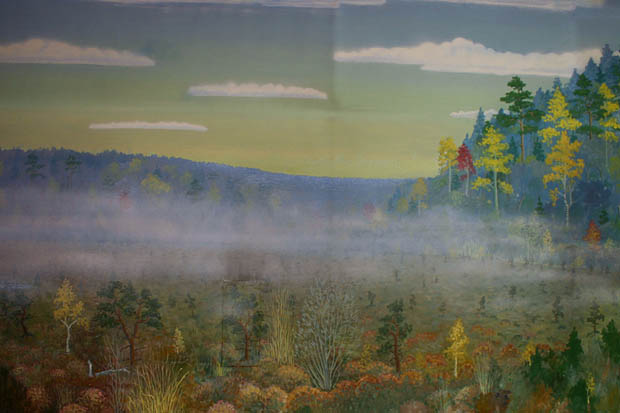
Pictures of the Zoological Museum from along the way
Visitors have been welcomed by various memorable animals at the curve of the stairs in the foyer. At first, the bronze elk stood there - well-known as the symbol of the Zoological Museum and made by the sculptor Jussi Mäntynen. A wild boar shot by the former president of Finland, Urho Kekkonen, followed. From 1989, visitors encountered an adult African elephant in the foyer.
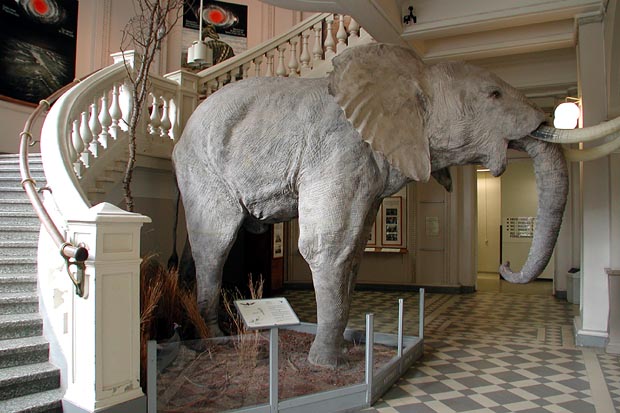
The Natural History Museum 1996-
As the exhibits developed and renewed, the name ‘ Zoological Museum’ became somewhat misleading. In addition to animals, displays included plants and rocks, and increasingly, the exhibits explained various phenomena in nature. The old gymnasium building was then indeed festively renamed The Natural History Museum.
In addition to the exhibits, the Natural History Museum is also known for its diverse public happenings, information events and workshops.
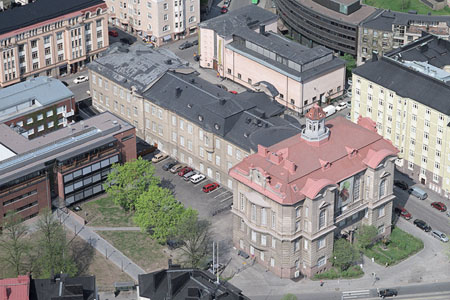
Renovation and remigration 2005–2008
The millennium brought major changes. The university’s Zoology Department, which had resided in the museum building, moved to the new campus in Helsinki’s Viikki in 2002. The near centenarian building began to show signs of its age, and so, in the autumn of 2005, the University of Helsinki launched the complete renovation of the building.
The entire museum building, from the boiler room to the attic, was emptied and closed from the public for nearly three years. The basis of the renovation was to conserve the building and “to peel out” the original flamboyance of the premises.
The walls separating the offices were removed, galleries where collections had been were taken down, and the floor of the 4 th floor was demolished from the auditorium. In addition to the auditorium, the foyer and staircase were restored to their original condition. Old walled-up arch-doors, -windows, and ceiling and wall-structures were uncovered from various parts of the museum during the renovation.
In total, 253 old wooden windows and about a hundred doors were renovated in the building. The original tile floors and herringbone design oak parquet was preserved and restored.